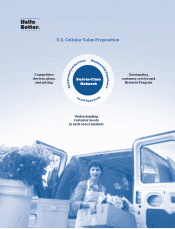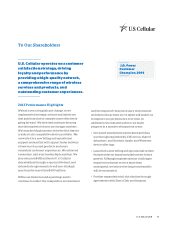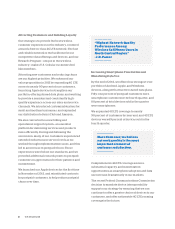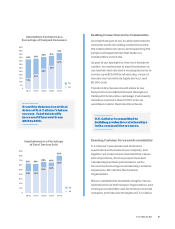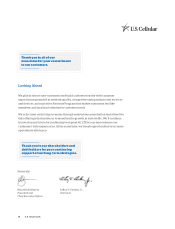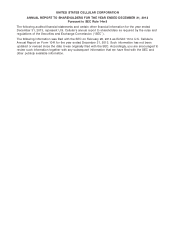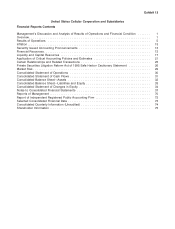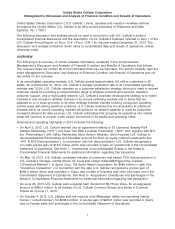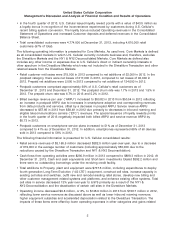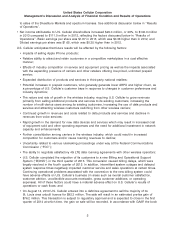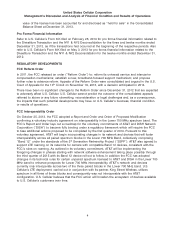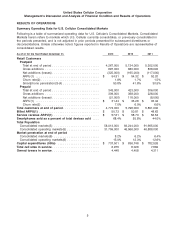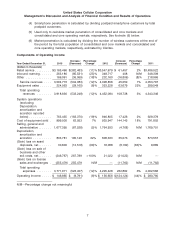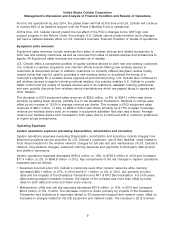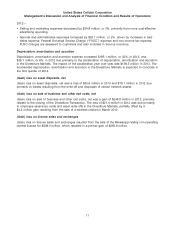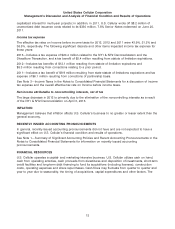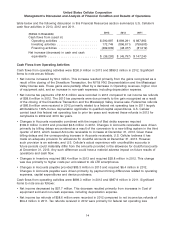US Cellular 2013 Annual Report Download - page 12
Download and view the complete annual report
Please find page 12 of the 2013 US Cellular annual report below. You can navigate through the pages in the report by either clicking on the pages listed below, or by using the keyword search tool below to find specific information within the annual report.United States Cellular Corporation
Management’s Discussion and Analysis of Financial Condition and Results of Operations
value of the license has been accounted for and disclosed as ‘‘held for sale’’ in the Consolidated
Balance Sheet at December 31, 2013.
Pro Forma Financial Information
Refer to U.S. Cellular’s Form 8-K filed on February 26, 2014 for pro forma financial information related to
the Divestiture Transaction and the NY1 & NY2 Deconsolidation for the three and twelve months ended
December 31, 2013, as if the transactions had occurred at the beginning of the respective periods. Also
refer to U.S. Cellular’s Form 8-K filed on May 3, 2013 for pro forma financial information related to the
Divestiture Transaction and the NY1 & NY2 Deconsolidation for the twelve months ended December 31,
2012.
REGULATORY DEVELOPMENTS
FCC Reform Order
In 2011, the FCC released an order (‘‘Reform Order’’) to: reform its universal service and intercarrier
compensation mechanisms; establish a new, broadband-focused support mechanism; and propose
further rules to advance reform. Appeals of the Reform Order were consolidated and argued in the U.S.
Court of Appeals for the 10th Circuit on November 19, 2013, with a decision anticipated in 2014.
There have been no significant changes to the Reform Order since December 31, 2012 that are expected
to adversely affect U.S. Cellular. U.S. Cellular cannot predict the outcome of the consolidated appeals
referred to above or any future rulemaking, reconsideration or legal challenges and, as a consequence,
the impacts that such potential developments may have on U.S. Cellular’s business, financial condition
or results of operations.
FCC Interoperability Order
On October 25, 2013, the FCC adopted a Report and Order and Order of Proposed Modification
confirming a voluntary industry agreement on interoperability in the Lower 700 MHz spectrum band. The
FCC’s Report and Order lays out a roadmap for the voluntary commitments of AT&T and DISH Network
Corporation (‘‘DISH’’) to become fully binding under a regulatory framework which will require the FCC
to take additional actions proposed to be completed by the first quarter of 2014. Pursuant to this
voluntary agreement, AT&T will begin incorporating changes in its network and devices that will foster
interoperability across all paired spectrum blocks in the Lower 700 MHz Band, collectively comprising
‘‘Band 12’’ under the standards of the 3rd Generation Partnership Project (‘‘3GPP’’). AT&T also agreed to
support LTE roaming on its networks for carriers with compatible Band 12 devices, consistent with the
FCC’s rules on roaming. As outlined in its voluntary commitment, AT&T will be implementing the
foregoing changes in phases starting with network software enhancement taking place possibly through
the third quarter of 2015 with its Band 12 device roll-out to follow. In addition the FCC has adopted
changes in its technical rules for certain unpaired spectrum licensed to AT&T and DISH in the Lower 700
MHz band to enhance prospects for Lower 700 MHz interoperability. AT&T’s network and devices
currently only interoperate across two of the three paired blocks in the Lower 700 MHz band. U.S.
Cellular’s LTE deployment, carried out in conjunction with its partner, King Street Wireless, utilizes
spectrum in all three of these blocks and consequently was not interoperable with the AT&T
configuration. U.S. Cellular believes that the FCC action will broaden the ecosystem of devices available
to U.S. Cellular’s customers over time.
4


